Mark Sisson's Blog, page 339
May 17, 2013
Going Primal Was Like the Magic Pill I Have Been Looking For
It’s Friday, everyone! And that means another Primal Blueprint Real Life Story from a Mark’s Daily Apple reader. If you have your own success story and would like to share it with me and the Mark’s Daily Apple community please contact me here. I’ll continue to publish these each Friday as long as they keep coming in. Thank you for reading!
 I grew up as an overweight child and teenager. It wasn’t that I ate particularly badly, it was that I absolutely hated sport. Growing up in the 80s, I really thought that exercise was synonymous with ball sports. As I was essentially scared of the ball, I didn’t want to kick, throw or catch it, and so I didn’t want to exercise. I had no idea that doing a martial arts or boxing class (which didn’t involve balls), participating in Zumba or even going for a simple walk could be exercise and could be fun.
I grew up as an overweight child and teenager. It wasn’t that I ate particularly badly, it was that I absolutely hated sport. Growing up in the 80s, I really thought that exercise was synonymous with ball sports. As I was essentially scared of the ball, I didn’t want to kick, throw or catch it, and so I didn’t want to exercise. I had no idea that doing a martial arts or boxing class (which didn’t involve balls), participating in Zumba or even going for a simple walk could be exercise and could be fun.
So I was basically inactive and fed the standard Australian diet of lots of healthy whole grains. As I was overweight my parents did all that they could to keep anything “fattening” away from me, and fed me as many “diet” and “fat free” products that they could find. I was eating a diet that consisted mainly of artificial sweeteners, no fat yogurt, diet coke and all bran.
That was when the stomach pains began. I developed such bad IBS that I would spend most evenings curled up on my bed with excruciating stomach cramps. My doctor gave me anti-spasmodic medication which I took on a daily basis. This was when I realised the limits of Western medicine – rather than try to work out why I was experiencing such bad cramps and bloating – I was given a pill to temporarily relieve the symptoms. I insisted on going to a number of specialists, who did the usual blood tests, didn’t find anything wrong with me, and told me that my IBS was caused by stress. I remember feeling utterly frustrated – the main stress I had in my life at that time was my stomach pains!
At about 16 I lost a lot of weight and became very calorie conscious. I was always a high achiever, and since I was taught that whole grains were so healthy, I decided that all that I would eat would be whole grains. I barely ate any protein, and absolutely no fat, and at this point started to develop reactive hypoglycaemia which has plagued me ever since.
During my early 20s I managed to keep very slim through huge amounts of cardio exercise, and on the outside looked like the picture of health. I ate healthily according to conventional wisdom. I discovered the joys of exercise without ball sports – I became an avid runner and a very enthusiastic boxer. I could talk for hours about the joys of an intense double spin class. I genuinely loved the exercise, however on the inside I felt like a sick person and was always exhausted. All of this cardio meant that I had intense cravings for carbs, and even though I would limit these to low-GI carbs like a bowl of muesli and toast, within half an hour of eating such a meal my blood sugar would be crashing and I would be shaking and slurring my words. I could go no more than an hour without eating. I could not leave the house without a bag full of muesli bars and sandwiches. I started working as a lawyer in a corporate law firm, and would dread the thought of morning meetings after an exercise session – I would need to excuse myself half way through the meeting to go to the bathroom and quickly scoff a sandwich to bring my blood sugars back up so that I could concentrate. My boyfriend at the time (now husband) knew that he had to keep me around food at all times, because if my blood sugar dropped, I went from being a sweet-natured person to a monster in seconds, ready to bite his head off. I could not stay awake past 9pm at night, and was permanently exhausted from my blood sugar swings. Even though I was slim (about 50kg at 162cm) I could only wear loose “maternity-style” tops and dresses to cover my stomach inflamed from IBS which always looked 6 months pregnant.
When I was about 23 my IBS symptoms got even worse and at that point I listened to the advice of a naturopath who told me to give up all artificial sweeteners and coffee. That did reduce my symptoms so I could stop taking anti-spasmodic medication, however I still experienced stomach pains, bloating and discomfort on a daily basis.
When I was 29 I went off the pill to try to fall pregnant, and discovered that somewhere along the line I had developed PCOS (most likely from my insulin problems and hypoglycaemia). The acne from my teenage years came back with a vengeance and my periods were irregular. It turned out to be due to genetic issues, and after a few twists and turns fell pregnant with twins. I couldn’t have been happier – it really felt like a miracle. Everything was going well until I reached about 21 weeks when I started to go into premature labour. I was having continuous contractions and immediately put on bed rest in hospital. The stress of bed rest was like nothing that I had ever experienced before – for 14 weeks I was told to lie perfectly still or else I could lose my babies. I took the doctors’ advice very seriously and did everything I possibly could to keep my babies inside of me for as long as possible.
While I was lying in bed (with lots of thinking/observing time), I started to notice that when I ate gluten or processed foods, my contractions would be much, much worse. I started to experiment with avoiding gluten, and came up with the hypothesis that gluten was causing my IBS, which was in turn was irritating my uterus and causing it to contract. When I ran this past my doctor he gave me a strange look, however despite his scepticism I cut out all gluten which I am quite sure helped keep my babies safe.
By some miracle I managed to stay pregnant until 35 weeks, and then gave birth by caesarean to perfect boy-girl twins of 2.3kg and 2kg. They stayed in hospital for a month when they were born, however they were healthy and I was over the moon. I used this month to start to move around again, rebuild some of my wasted muscles and prepare for my twins to come home. During my pregnancy I only gained about 10kg, most likely due to muscle wastage and the fact that I was so nervous to eat anything that could cause contractions that I stuck to plain rice, plain chicken, beef and fish, eggs, steamed veges, avocados, bananas and berries. I guess at that point I was eating mostly primal without even knowing it. Unfortunately the public hospital system food left much to be desired in terms of food quality – powdered eggs for breakfast and congealed chicken for lunch. My husband was amazing by bringing me home cooked scrambled eggs and sweet potato most mornings.

As soon as the twins were born I was so happy not to have to worry if what I ate would affect my babies that I went straight back to eating gluten and other processed foods. The lack of sleep, trying to breastfeed 2 babies and eating carbs and gluten meant that I started to feel awful once again. When the babies were about 6 months I started to search for answers on the internet, knowing in the back of my mind that gluten may be an issue for me (as well as many other preservatives and sweeteners), but not knowing where to start to address my issues. This was when I stumbled on MDA, and like many others have said before me, I spent every waking moment (that I was not tending to babies) reading everything I could on the site. It felt like everything fell into place, and finally I had found a voice to not only define my problems, but to give me realistic solutions to those problems. I had always felt like I was the only one who experienced embarrassing stomach issues and blood sugar swings, and now finally I discovered that there was a whole community of people who were experiencing exactly the same thing.
Literally within a few days of giving up gluten and other processed foods, my IBS symptoms disappeared. It was like being given a magic pill. My acne cleared up and I began to sleep more deeply. Whereas before I was grumpy with tiredness all evening, I could start to function in the evenings and become more social. I could easily jump out of bed to go to a crying baby in the middle of the night, and suddenly had no trouble getting up in the mornings even with very little sleep. I did succumb to the low carb flu and it took quite some time to adjust to the low carbs without experiencing hypoglycaemia (probably at least a month). After this I could finally go to a work meeting without the panicked thought that my blood sugar would drop and I would not be able to string a sentence together.
There were also issues that were resolved by eating primal that I did not even realise were issues – for example, I used to get very sweaty feet and had to use foot deodorant if I wore stockings. After going primal my feet stopped sweating and I haven’t bought a can of deodorant since. Things that used to stress me out no longer stress me. I am able to focus better at work and am more productive and even tempered. My husband, who is primal by default (i.e. he doesn’t want to eat primal but there is nothing in the house that is non-primal) has effortlessly lost 6kg, even though he eats non-primal at work and when he is out on the weekends.
I jumped on board with the primal way of exercising. Even though I was very reluctant to give up my beloved spin classes, I soon realised that while spinning gave me a momentary endorphin high, I was left with the inevitable blood sugar crashes and intense carb cravings. I now lift weights 2-3 times per week and sprints once per week, with walks whenever I can fit them in. (I must admit that I have found walking the hardest thing to fit into my schedule, as it is the most time consuming. While I can sneak in a cheeky 20 minute sprint session while my kids are playing, to keep 2 restless toddlers in the pram while I walk for an hour is near impossible).
I can’t say that being primal has been some magic bullet in terms of weight loss, although I didn’t have much weight to lose. I certainly shed fat and put on lean muscle after the pregnancy, and my weight is now held stable at about 52kg, which is slightly over my pre-pregnancy weight. It has also taken me about 18 months of healing with good food and supplements to get my hypoglycaemia under control. I can now control my blood sugar and cravings by eating very low carb throughout the day, and can even handle some carbs last thing at night. If I have carbs in the morning I know that the rest of the day will be ruined as I try to play catch-up with my falling blood sugars.
I would have to say that the biggest gift that being primal has given me is time and energy to spend with my twins and husband. I no longer have to spend hours on a treadmill or cross trainer, and can rather focus on playing with them. At the same time the biggest challenge that I have faced is trying to feed my twins primal food, and all of the resistance that I face from family and those around me. My father, who is a doctor, jokes that he is going to call child services on me for feeding my children coconut oil and clogging their arteries. However, now that I have been primal for nearly 2 years and am so happy for it, they can see that there is some merit in the efforts that I go to in order to feed my children well.
I don’t have any dramatic before and after pictures, however here is a photograph when I had just given birth to my twins (above), and here are some photos a year later after being primal for 6 months.

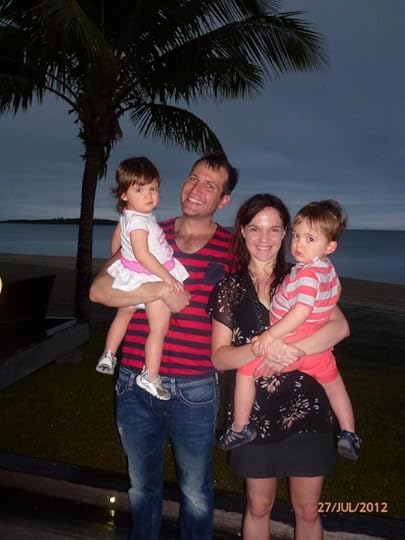
Grab a Copy of Primal Cravings: Your Favorite Foods Made Paleo and Claim Your FREE Gifts While the Limited-Time Offer Lasts!

May 16, 2013
Why It’s Important to Cook Your Own Meals
 When was the last time you made a great meal? From-scratch prep, serious gratification result. This morning? Last week? Last month? Although I imagine Primal folks cook much more often than most non-Primal types, we all get caught up in the busyness of life. Eating – even healthy eating – often gets boiled down to convenience and strategy. I get it. Few of us have the luxury of basking in culinary ventures at every meal (myself included), but I do find real cooking to be an underappreciated indulgence – and there’s the rub.
When was the last time you made a great meal? From-scratch prep, serious gratification result. This morning? Last week? Last month? Although I imagine Primal folks cook much more often than most non-Primal types, we all get caught up in the busyness of life. Eating – even healthy eating – often gets boiled down to convenience and strategy. I get it. Few of us have the luxury of basking in culinary ventures at every meal (myself included), but I do find real cooking to be an underappreciated indulgence – and there’s the rub.
Why, as a larger culture, have we chosen to forgo so many of these gifts – taking extra time to shop for better food, creating meals together, lingering at the table? For example, we can look at statistics that say the average American spends only 27 minutes on food preparation each day and wonder – are we really that busy? What are we rushing off to? Then we see average T.V. viewing is 151 hours a month! (How is this even possible?) Clearly, our priorities are royally screwed up.
Of all the things we can do for our health, many (if not most) are just outright enjoyable, pleasurable even. Connecting with our food can be exactly that – from absorbing the joys of gardening to relishing the sensory delights of great recipes to reclaiming the social hour for dinner. As for cooking itself, learning to cook is just one of those essential human skills. It was an evolutionary linchpin. Our hominid brains as well as our bodies benefited from the chance to access new food sources that were only available to our ancestors through cooking. And it wasn’t just about heat. As we learned to adapt food sources in other ways such as soaking, curing, fermenting and smoking we had more options for calories and nutrition. Yet, it was more than that.
According to anthropological interpretation of surviving evidence, the ritual of food preparation for our hunter-gatherer kin started tens of thousands of years ago in meat sharing practices. (Evidence of large scale feasts date back at least 12,000 years, proving Grok and his buds really knew how to throw a good dinner party.) The point is, even in those “short and brutish” days, it wasn’t all kill the beast, chop it up, and eat it. Food preparation, merging into ceremony, took on a social and cultural life of its own beyond consumption.
In every human society since, there’s been rich and varied tradition associated with food preparation. Religions of nearly every brand have food related rituals regarding how meals are to be prepared, shared, or timed. We see it still in the age-old practices that keep food Kosher or in the preparation of feasts for our most treasured holidays, in the tradition of serving a meal following a wedding or burial. Some cultures, like the Greeks, even have specific foods customary for the burial event.
Even today, there are few things so resoundingly primal as preparing food to create meals (for large or small scale). There are the smells, the blood and the flames. There are the messy hands, drunken senses (literal or figurative depending on how much of the cooking wine you tested), the heightened, tactile creativity. Is cooking essential to the Primal Blueprint? I’d say you have a hard time getting around it without a Primally trained personal chef (there’s a thought). Cooking, on some level, is necessary for the PB and is beneficial to a profound degree.
Eating in is in almost every case healthier (and much more economical). Most of us would be hard pressed to find a Primal restaurant near us (they do exist), and even in better restaurants with local and organic suppliers, there are the still the question marks lingering on the menu. What kind of oil do they use for cooking? What kind of cookware? While I enjoy going out and have no intention of forgoing that pleasure, there’s a certain peace in knowing every facet of my dinner. Compared to the larger landscape of conventional “dine out” choices, you’re astronomically better off eating in.
The better cooks we are, the richer and more varied our diets can be. The principle worked for our ancestors’ collective health, and it applies to us individually today. Like our ancestors, the right techniques open up new food possibilities for us – like cheaper and otherwise tougher cuts of meat. Additionally, many foods may be wholly uninspiring on their own but become fast favorites when paired with the right sauce or some novel herbs. As we expand our repertoire, we lessen the chance that we’ll get bored with our choices.
A few key cooking techniques and kitchen skills can go a long way in making our Primal dishes healthier and more satisfying. You get a lot of mileage, for example, in terms of both flavor and nutrition when you can make your own batches of bone broth and use them creatively with meat dishes, sautèed vegetables, or basic sauces. Braising opens up a whole new world with certain meats. Roasting can make certain vegetables glorious that you wouldn’t touch steamed. Playing with fats and incorporating them into – well, everything – can give your food levels of flavor that will confound your dinner guests and satisfy you to no culinary end. The end result of all these endeavors just might be you, Primal chef, developing a nuanced palate and kitchen wizardry you couldn’t ever imagine wanting – let alone having. What do you know – you got skills. And a damned good dinner at that.
Thanks for reading, everyone. What do you think? Could you be Primal and not cook your own meals? Did you come to Primal living with a penchant for cooking, or did you learn along the way? Have you discovered an appreciation for time spent in the kitchen? Have a good end to the week.
Grab a Copy of Primal Cravings: Your Favorite Foods Made Paleo and Claim Your FREE Gifts While the Limited-Time Offer Lasts!

May 15, 2013
7 Characteristics Associated with Long Life (and How to Cultivate Them)
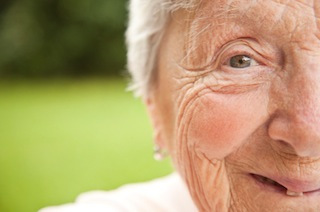 As much as we focus on food and fitness as the “physical” arbiters of health and longevity, there appears to be much more to it. In fact, most research fails to find any grand commonalities in the diet and fitness patterns of the longest lived. From Okinawans with their sweet potatoes to Japanese centenarians with their dairy to the Ashkenazi with their higher rates of smoking, drinking, and lower rates of formal exercise to the 107 year old with her butter, no exercise, and mistrust of medicine to the supercentenarians with their liver, bacon, wine, chocolate, and eggs to the other supercentenarians with their caloric restriction. Sure, they’re generally not eating Twinkies and Panda Express, but the secret to longevity – at least as it’s practiced by living centenarians – does not lie in one specific diet.
As much as we focus on food and fitness as the “physical” arbiters of health and longevity, there appears to be much more to it. In fact, most research fails to find any grand commonalities in the diet and fitness patterns of the longest lived. From Okinawans with their sweet potatoes to Japanese centenarians with their dairy to the Ashkenazi with their higher rates of smoking, drinking, and lower rates of formal exercise to the 107 year old with her butter, no exercise, and mistrust of medicine to the supercentenarians with their liver, bacon, wine, chocolate, and eggs to the other supercentenarians with their caloric restriction. Sure, they’re generally not eating Twinkies and Panda Express, but the secret to longevity – at least as it’s practiced by living centenarians – does not lie in one specific diet.
So what is it? One main determinant appears to be whether you have certain alleles. You can’t change that (not yet anyway), but there are some things you can control. What you can affect – and what appears to have a big effect on, or at least a strong association with longevity – are personality traits and characteristics. How you see the world. How you engage life. How you interact with others. Now, to be sure, many personality traits are somewhat out of your conscious control, whether genetically determined or set in motion by events long-past, but that doesn’t mean you can’t try to cultivate or emulate them.
What are some of these characteristics?
Socially Connected
Perhaps one of the prime directives of the human is to be social. To have friends and loved ones upon whom you can lean when required or desired. I’m not necessarily talking about being the guy with a thousand Facebook friends who’s out every night living it up, or even the lady who always runs into someone she knows when out and about. Socially connected simply means having meaningful relationships with other people. It could be ten, twenty, or five. The point is that it helps to have actual, real friends and loved ones, and we’re probably evolutionarily driven to want and make them because they provide a benefit to survival.
Why might social connections support longevity? The research is ongoing, but I can think of a few reasons. First, people with meaningful relationships can call on them for help in times of need and hardship. Need some rent money or to pay for an important surgical procedure? You can probably count on friends and family to help. Recovering from said surgical procedure and need someone to help you get groceries and cook? Call a friend or family member. Need a ride? Call someone you know. If you don’t know anyone you can count on, your options will be limited.
Second, social isolation and loneliness are often associated with negative health patterns, like obesity, inactivity, and smoking. Plus, the socially isolated and lonely are more likely to have hypertension, elevated inflammatory markers, and increased blood clotting. In one study, people who had close friends in the same room with them had less of a blood pressure and heart rate increase in response to stress. Another study found that in people exposed to a cold virus, those with more social connections were less likely to actually get sick than those with fewer social connections.
It’s good to have friends. All else being equal, the person who’s happy with their relationships is probably going to live longer than the person who’s unhappy with or bereft of social connections.
Cultivation:
Use social networks like Facebook and Meetup to arrange real life activities and augment your social lives. Make plans with friends and follow up on them. Join a Meetup group that sounds interesting and attend the events. It’s easy to let social media replace our social interactions, but it’s not a preordained inevitability.
Don’t be that person who regrets not calling/contacting their friends more. Some people truly have no friends or family, but that’s rare. More often than not, people just aren’t willing to make the effort, maybe because they don’t see the need, maybe because they’re lazy, maybe because they’re anxious, or maybe because they’re waiting for the other person to contact them. Be proactive in fostering and maintaining the relationships you already have.
Conscientious
According to health researchers Howard Friedman and Leslie Martin, conscientiousness is a big (perhaps the biggest) influence on longevity. Using data from a study that began in 1921 and followed a group of 1500 boys and girls into old age and beyond, the two found that the kids who were “prudent, persistent, planful” went on to live the longest lives, while the “cheerful and optimistic” children lived shorter lives. The former group tended to take fewer risks, be more responsible about their health, and cultivate a better social network. They also had more satisfying and successful professional lives. Overall, the persistent, industrious, organized, and disciplined “facets of conscientiousness” were most strongly associated with longevity.
This connection is well-researched. Conscientious people tend to be healthier and take better care of themselves. Childhood conscientiousness is linked to better health later on in life. Most of the connection between conscientiousness and longevity can be explained by obvious factors, like the fact that thoughtful people are more likely to care about their diet and other health-related behaviors and therefore make better health-related decisions, but not all of it. Conscientiousness, for example, also seems to go hand-in-hand with cognitive function and it may even be protective against Alzheimer’s and other diseases of cognitive degeneration. Those who are conscientious may also deal with stress better than those who are not, probably by virtue of being better prepared for it.
There’s got to be a balance, though, I’d imagine. What if conscientiousness veers into obsession? What if dedication to self-discipline devolves into self-flagellation? What if hard work becomes workaholicism and breaks up your marriage?
Cultivation:
Practice, practice, practice. Make schedules and budgets. Plan out your day, and hew to the plan. If you aren’t naturally disciplined and organized, you can still become conscientious – it’s just gonna be a bit harder.
Don’t just self-analyze. Ask others close to you about their perception of your conscientiousness, and adjust accordingly. After all, the original 1921 study analyzed the kids’ personalities by asking their parents, not the kids themselves.
Don’t Worry Too Much
Longer lived people (and waterfowl) are able to let things slide off their backs. They tend to be easy going and don’t get hung up on silly stuff as much. Consider the interplay with conscientiousness, however. Just as too much conscientiousness might manifest as obsessiveness and lead to poorer health and longevity, being too carefree might lead to poor decision-making and flagrant abuse of one’s health. A balance is likely best, where you don’t sweat the small stuff enough to heap unnecessary stress upon your back but take the important aspects of life seriously.
Cultivation:
Don’t cry over spilled milk (unless it’s raw and comes from grass-fed Jersey cows, of course). Better yet, get down on the floor and lap it all up.
Forgive people. If there’s something you’ve been mulling over, some perceived slight, some past transgression, consider forgiving that person and moving on.
When you’re worked up about something, stop and ask yourself what exactly is bothering you so much. Get specific when you answer. You might just find there’s nothing there.
Make a list of all the things you tend to worry about. Then, objectively analyze the relative “seriousness” of each item. Discard the items that aren’t very serious. Make specific plans to take care of the serious items that merit your attention. Once this is completed, you’ll have discarded the frivolous stressors and made plans to tackle the serious ones. The point is you’ll have less to worry about now.
Look into Stoicism. Here’s a decent representation of what it’s all about. You can’t control everything, and you have to be okay with that.
Explore stress-reducing herbs and teas.
Meditate.
Optimistic
Seemingly contrary to the other findings about optimistic kids dying earlier, some research suggests that optimism is a good predictor of longevity. Optimists are more resistant to stress, generally lead longer and healthier lives than pessimists, and, well, optimism seems to be encoded into our genome. According to neuroscientist Tali Sharot, “optimism was selected by evolution precisely because, on balance, positive expectations enhance the odds of survival.”
I wrote about this last year. Optimists, quite simply, are fighters. They’re fighters because they can see a point to it all, a light glimmering at the end of the tunnel, and so they continue on. They don’t give up, because why would you if things are going to work out? To an optimist, things only fail because you gave up on them. If you’re faced with a cancer diagnosis – say, lung cancer – and you’re an optimist, you’re more likely to survive longer.
Cultivation:
Look at the bright side of a “bad” situation. That’s it. Just look at it. Perceive it. Observe it. Acknowledge it. When you do that in an objective way, you can’t help but feel a little better about the situation.
Throw yourself out there anyway. Things aren’t that bad. Trust me. When you actually go out and face it and it goes okay, you’ve just learned that things aren’t always as bad as you assume.
Get those small wins that lead to big success (and optimism).
Easy to Laugh
There’s considerable research that ease of laughter is a strong predictor of longevity. He who laughs most, laughs last, in other words. Laughter isn’t just enjoyable. It’s also really good for you. It reduces stress and improves natural killer cell (a part of your immune system responsible for fighting cancer and other diseases) activity. It lowers cortisol. While growth hormone is best known for its fat-burning effects, it can also have a negative impact in rheumatoid arthritis; laughter reduces the RA-associated growth hormone increase. Overall, laughter simply has “positive, quantifiable effects on certain aspects of health.”
Cultivation:
Watch funny media. Whether you like Laurel and Hardy or Tim and Eric, find something that you determine generates a high level of mirthful activity in your brain and expose yourself to it, repeatedly.
Watch standup. I recommend Louis CK.
Just laugh. This sounds obvious, but you don’t even have to find something funny in order to laugh. In the immortal words of George Costanza, “What is the point of opening your mouth and going ‘Ha-ha!’?” It’s that easy. Force yourself to laugh and the real feelings will likely follow. Do this once a day, minimum.
Try laughter yoga. It’s exactly what it sounds like.
Happy
In 2011, a study of older men and women found that those who were happiest throughout the day lived the longest. Interestingly, this association was independent of baseline health status or other variables, suggesting that momentary happiness “may be causally related to survival, or may be a marker of underlying biological, behavioral, or temperamental factors.” Even those with chronic diseases saw longevity benefits from being happy.
I think this comes down to something very simple: happy people have “something to live for.” They have a reason to get out of bed in the morning. Yeah, yeah, a meaningful career, grandkids, a loving spouse, a faithful dog – these are all good reasons to keep living. But when it comes down to it, if you can wake up confident in the fact that your day is going to be an enjoyable, happy one, you will live better and live longer.
Cultivation:
Live life. Unless we’re talking chemically-induced happiness, happiness doesn’t just spring up out of nothing. You are happy because good things are happening in real, actual life. Maybe you just got a puppy or a girlfriend. Maybe you got a great new job. Maybe you’re reading a good book. Maybe you went on a hike and the flowers were blooming. The point is happiness is a reaction to happy events. You’re not really going to be able to “think yourself” happy.
Do things that you know you’re going to enjoy and appreciate even if they require momentary unhappiness. You know how you’re always happy when you get up early enough to do some gardening (or hike, or work out, or clean the kitchen, or make a good breakfast) before it gets too hot (or late), but getting out of bed to actually do it is a short struggle that you usually lose? Just do it anyway. It’s not that bad. Play the long game.
Extroverted
Extraversion is a significant predictor of longevity, happiness, resistance to stress, and even mood regulation in the face of unpleasant situations. I tend to suspect that introverts might not live as long not because of something inherent to introverts, but because modern society is geared toward and favors extraversion. An introvert probably experiences more stress in response to social fundamentals, like job interviews, small talk, presentations, and anything else where extraversion helps. You can be introverted and completely comfortable with that fact and be totally fine, or at least minimize the downsides. But if you’re an introvert who’s unhappy, who’s envious of extroverts, you may suffer.
Also, extraversion is more “costly.” A study of older adults found that in order to maintain their psychological well-being, extraverts needed large social networks.
Cultivation:
Act the part. Even though social interaction may be more difficult for introverts, “acting like” an extrovert can increase well-being just the same, even in introverts.
Start a conversation at least once a day. Go up and talk to people.
Introversion does not imply social isolation. You may not be the life of the party, but you can still have quality relationships – perhaps just with fewer people.
That’s about it for today, folks. I hope this was a helpful post and that you can begin cultivating some of these traits in your own lives. Be sure to let me know what you think – any good anecdotes about the personalities of long-lived people you’ve known?
Grab a Copy of Primal Cravings: Your Favorite Foods Made Paleo and Claim Your FREE Gifts While the Limited-Time Offer Lasts!

May 14, 2013
The Missing Link: Movement as a Skill
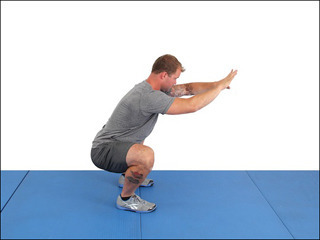
This is a guest post from Kelly Starrett. Kelly is an expert on performance-based orthopedic sports medicine, and the founder and operator of CrossFit San Francisco. He also blogs at mobilitywod.com, presented at this year’s PrimalCon Oxnard to rave reviews, and has a great new book out, Becoming a Supple Leopard. He’s been busy! Now, enter Kelly…
Humans have the amazing ability to resolve their own pain and heal themselves…infinitely. Although this might be difficult to believe, especially if you are suffering from chronic pain, with the proper lifestyle choices, you have the brilliant capacity to correct motor control errors and alleviate pain at any age, forever.
However, a proper lifestyle doesn’t simply mean managing your nutrition, sleep, stress, hydration, and exercise. To become an impeccable healing machine, you also need to understand how to move safely and effectively in all situations.
The equation looks something like this:
Right Lifestyle + Correct Movement = Impeccable Healing Machine
It’s simple. The way you move and the positions you acquire throughout the day have a direct impact on your overall health. It turns out that sitting with a rounded back, standing with your lumbar spine overextended, walking with your feet turned out, or squatting incorrectly can, overtime, wreak havoc on your overall quality of life. Imagine exercising or trying to get a full night of sleep when your low back is glowing with pain. It’s not going to happen. As long as you are in pain your sleep is compromised.
Here’s the problem: People usually wait until they’re injured, overweight, or sick to address their issues. Just as you shouldn’t have to wait for a diabetes diagnosis to know you should stop eating a heaping pile of cake at every meal, you shouldn’t have to wait to blow out your knee or herniate a disk in your back to know that you should stop moving as if you were constructed from steel. Again, it’s not rocket science. If you don’t like being sick, you adopt a healthy lifestyle to prevent the onset of disease. Learning from this logic, if you don’t like living in pain, which I’m sure you don’t, you learn how to move correctly.
You can eat gluten-free, get eight to nine hours of sleep in a pitch black room, exercise daily, and drink a ton of water, but if you’re not moving with good form, it’s a problem – especially if you’re playing sports and lifting heavy weight. Look, if you’re going to live to be a hundred and twenty years old (it’s possible), you have to start treating position and movements as a skill.
In my book, Becoming a Supple Leopard, I provide a master blueprint for all human movements. But for the purpose of this blog, let’s isolate and discuss one of the most important transferable human movements, which also happens to be one of the Four Essential Primal Movements – the squat.
Squat Technique
The squat is more than just a strength-based exercise done at the gym. It’s how humans lower their center of gravity. Think about it. Every time you sit down on the couch, get up out of a chair, or remove yourself from the toilet, you’re performing a close iteration of a back squat. On any given day you most likely perform hundreds of squats. Now, imagine what happens if you have bad squatting technique: Your body lets you know that you’re doing something wrong by firing the pain signal. You might not feel the consequences immediately, but eventually it will catch up. And when it does, you’ll wish you had paid more attention to the quality of your movement.
Here’s the deal. Squatting with bad form has transferable consequences. For example, if your knees cave inward, your ankles collapse, or you overextend at your lumbar spine while performing your hundred-plus squats per day, chances are good that you will exhibit these very same faults during loaded, dynamic movements, such as jumping and landing. It’s no wonder so many people suffer from low back pain or blow out their knee before age thirty.
You should look at the squat as a diagnostic tool for identifying movement faults and limitations in mobility. If you can’t squat butt to ankles without defaulting into a poor position (rounding your back, knees tracking inward, etc.), it’s an indication that you either a) don’t understand how to perform the movement correctly, or b) you are missing range of motion in one or more areas of your body (i.e., dorsiflexion, hip internal rotation, tight hamstrings). Luckily, both issues have solutions. Bad form can be fixed by learning the proper movement in stages, and a restricted range of motion can be fixed through regularly practicing specific mobility exercises (all of which are found in Becoming a Supple Leopard).
The bottom line is you need to learn how to squat correctly and then practice the proper mechanics every time you lower your center of mass, whether you’re back squatting in the gym, picking something up off the ground, or sitting down and getting up off a chair. It’s the same technique.
Step 1: Get organized

The key to executing a perfect squat is to start in a good position. This means bracing your spine in a neutral position and creating torque (stability) by screwing your feet into the ground.
To begin, establish your squat stance with your feet just outside your shoulders with your feet straight – somewhere between 5 and 12 degrees – and your weight centered over the center of your feet or just in front of your ankles. Note, the straighter your foot position, the more torque you can create. And the more torque you can create, the easier it is to maintain stability (good position) as you descend into the squat.
Next, squeeze your glutes as hard as you can, align your ribcage over your pelvis, and then lock in the position by engaging your abs. Keeping your belly tight, screw your feet into the ground as if you were trying to spread the floor. To be more specific, screw your right foot into the ground in a clockwise direction and screw your left foot into the ground in a counterclockwise direction.
Finally, align your ears over your shoulders and look forward to maintain a neutral head position. As you do this, set your shoulders in a stable position and tighten your upper back by lifting your arms to chest level, pulling your shoulders back, and externally rotating your hands slightly.
Step 2: Load your hips and hamstrings
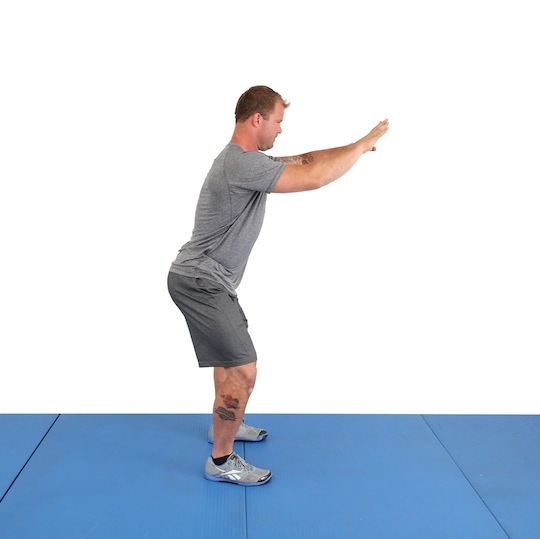
Keeping your back flat, reach your hamstrings back, drive your knees out laterally, and start lowering into the bottom position. Note: I say, hamstrings back because the drive your hips back cue can cause people to overextend at their lumbar spine. In addition, focus on keeping your shins as vertical as possible. This allows you to channel your weight and power into your hips and hamstrings, which are the muscles designed to handle the load. If your knees translate forward, you’ll lose power from your posterior chain and increase the shear (twisting) forces to the soft tissues within in the joint (patellar tendon, ACL, etc.)
Step 3: Pull yourself into the bottom of the squat
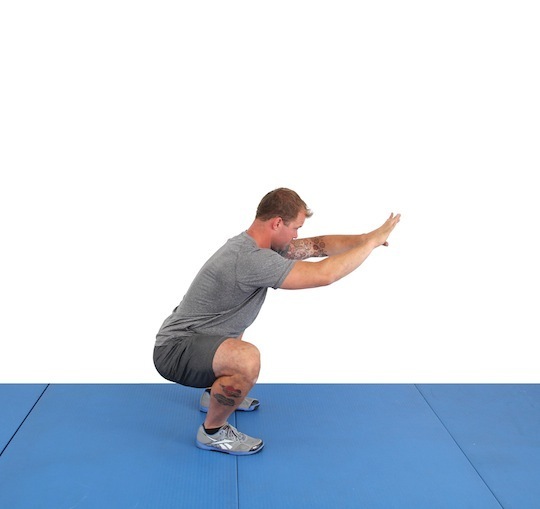
Most people have no trouble bracing their spine in a neutral position and hinging from the hips. Lowering into the bottom of the squat, on the other hand, is where things start to fall apart. This is where the invisible becomes visible. If you’re missing range of motion or you don’t have the motor control to perform the movement, this step in the sequence will illuminate your weaknesses.
As you lower into the bottom position, continue to screw your feet into the ground and drive your knees out – keeping your back flat, belly tight, and shins vertical. To maximize tension in your hips and hamstrings, think about pulling yourself into the bottom position instead of dropping into the bottom position. The goal is to drop your hip crease below your knee crease.
It’s important to note that if you can’t descend into the bottom of the squat with proper form, you should reduce the depth of the squat. The last thing you want to do is ingrain wonky movement patterns for the sake of performing the full range movement. It’s a simple rule: Don’t sacrifice form for range.
With that being said, every healthy human being should be able to perform a butt-to-ankle squat. After all, the bottom of the squat is really just Grok’s Paleolithic chair.
Step 4: Drive out of the bottom position
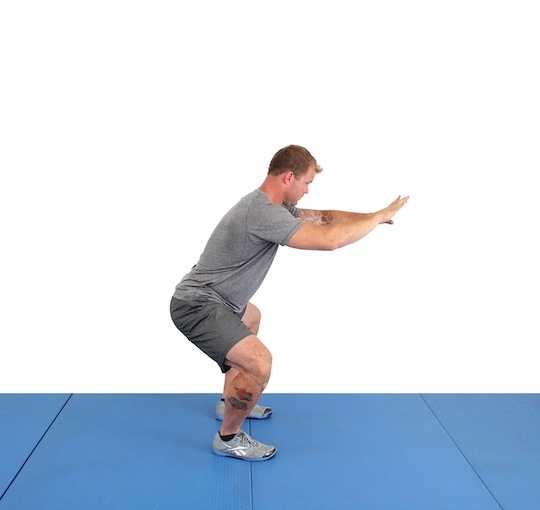
Rise out of the bottom position the same way you lowered into the squat: with your trunk braced, your back flat, your knees out, and your shoulders and upper back tight.
Step 5: Reestablish the top position
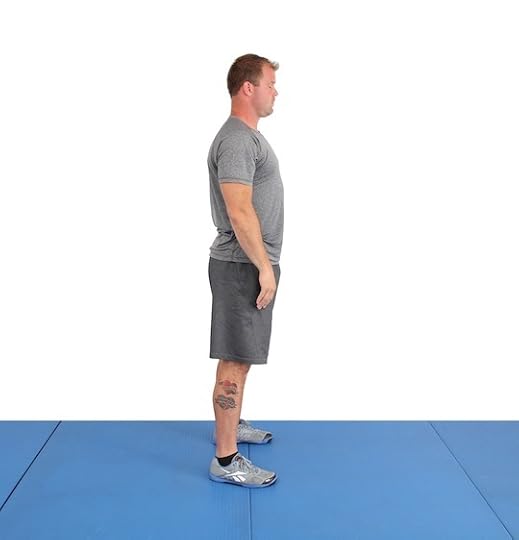
As you stand up, reestablish the top position by squeezing your butt. Remember this sequence and practice it every time you squat.
Mobility Rx
Learning how to squat with good form is always the first step. But what if you can’t keep your shins vertical or your back flat as you descend into the bottom position? What if you can’t keep your feet straight and your knees out as you hinge from the hips? Well, assuming it’s not a motor control issue – meaning you understand how to perform the technique correctly – there’s a good chance that you’re missing range of motion in one or more of your joints and tissues.
Pinpointing the problem area can be difficult. Your body is a system of systems. It takes some experimenting and some diligent mobility-time to get to the bottom of your business. The key is to spend time mobilizing in the positions that are giving you the most trouble. For example, if you’re unable to open up your hips in the top position because your hip flexors are tight, perform the Couch Mob. If you’re struggling in the bottom of the squat, mobilize in a position that looks like the bottom of the squat. Simple.
Couch Mobilization

Single Flexion with External Rotation Bias
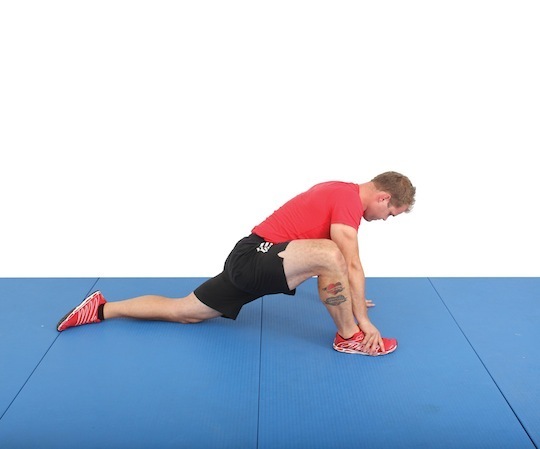
If you’re missing range of motion or you’re in pain, you can do something about it. Remember, you are an impeccable healing machine. Adopt the right lifestyle and get to work on fixing your crummy positions and movements.
To help illustrate how position and mobilization techniques can improve your squat, here are some relevant MWOD (Mobility Workout of the Day) videos:
Squat Quick Test: Is It Your Ankles or Hips?
Episode 363: Pre-Squat Hip Opener Mob-Rx
To learn more about Kelly Starrett’s Movement and Mobility system, check out his new book, Becoming a Supple Leopard: The Ultimate Guide to Resolving Pain, Preventing Injury, and Optimizing Athletic Performance and visit mobilitywod.com

May 13, 2013
Dear Mark: Hiking Around the World
 Today’s edition of Dear Mark is different than most. Instead of doing a roundup of questions, I’m focusing on a single email from a reader who’s hiking around the world in three years and needs a few bits of advice. Of course, this particular reader’s question contains four separate questions, so it’s kind of like a roundup. First is my opinion on the ideal macronutrient ratio – if such a thing exists – for an 18,000 mile hike lasting three years. Second is my opinion on a “fast and feast” cycle for the duration. Third is my take on the place of noodles and rice on a three year hiking trip. Fourth, I offer one final piece of advice.
Today’s edition of Dear Mark is different than most. Instead of doing a roundup of questions, I’m focusing on a single email from a reader who’s hiking around the world in three years and needs a few bits of advice. Of course, this particular reader’s question contains four separate questions, so it’s kind of like a roundup. First is my opinion on the ideal macronutrient ratio – if such a thing exists – for an 18,000 mile hike lasting three years. Second is my opinion on a “fast and feast” cycle for the duration. Third is my take on the place of noodles and rice on a three year hiking trip. Fourth, I offer one final piece of advice.
Let’s go:
Dear Mark,
I depart in summer for a 3 year, 18,000 mile continuous hike around the Earth, via Europe, Asia, Australia and the US. As part of the prep/training I have been paleo for over a year (loving it). Diet and training have been mostly PB standard, and I’ve kept paleo on week long training hikes.
Given the excessive kit I need to carry (up to 50lb) I’ll be chewing through 5000cal daily, and require a sustainable and shop-able diet. Not wanting to down a pint of grease every day, what sort of carbs/protein should I be aiming for? I assumed not more than 300g protein (to avoid ammonia build up and associated thirst) perhaps 200g carbs, leaving over 330g fat (still nearly a pint!)
So, the questions:
1 – Is a 20:30:50 CPF ratio sensible? or would you recommend a different ratio?
2 – What is your opinion on a continuous “fast and feast” cycle (eg 6:1 days) (fast in this case being 2000 to 3000 cal)?
3 – Should/could I include some easy lightweight carbs such as noodles or rice?
4 – Have you any other suggestions in any regard?
Thank you for your time, it is appreciated as is the MDA site.
Gus
P.S.
I had thought that a weekly schedule of 20 miles for 5 days, 30 miles for 1 day, then rest for a day at a food stop for a serious binge. This approach seems logical to me, especially as I usually throw in a Tim Ferriss style binge once every few weeks. I know to expect to take what I can get on the road, and have done training-fasts (0cal + 10km) up to 5 days.
Fortunately, the traditional nomadic diet of the Kazakhs is mostly horse fat and fermented mares’ milk is still prevalent, though some areas I pass, such as northern India, are mostly vegetarian.
I will be using body-centred load pack (Aarn bodypacks) and minimalist boots (Russell moccasins) to keep as natural a gait as possible.
I appreciate that any suggestions/recommendations you give are taken at my risk.
Thanks again.
First of all, I’m jealous! What you’re doing is precisely what I’d like to do if I was younger with fewer responsibilities. You’re going to have an incredible, life-altering time and come out a better, changed man for it. Now, for the questions:
One.
20 miles a day with 50 pounds on your body is going to be rough.
Take a look at Table III from this paper (PDF), which details the respiratory exchange ratio (RER) of subjects doing loaded marches. The RER is a rough approximation of the type of fuel being burned by the body. An RER of 0.7 means almost pure fat-burning, while an RER of 1 and above means almost pure carb-burning. By looking at the RER in response to marching with different loads up different grades, we can get an idea of what type of fuel you’ll be burning on your trip.
RER of people carrying 25.2% of their body weight was 0.87 (0% grade, flat ground), 0.89 (5% grade), 0.94 (10% grade).
RER of people carrying 32.7% of their body weight was 0.9 (0% grade), 0.92 (5% grade), 0.99 (10% grade).
RER of people carrying 38.4% of their body weight was 0.91 (0% grade), 0.91 (5% grade), 0.96 (10% grade).
RER of people carrying nothing at all – so just walking along a flat surface – was 0.85. That’s a roughly even mix of fats and carbs.
Generally, the higher the load and/or the steeper the grade, the higher the RER and the greater the reliance on carbohydrates. This should come as no surprise, as increasing the weight you’re carrying and walking up a steeper grade while doing it increases the work being done and shifts it toward the anaerobic pathway.
As the heart rate increases, your RER and reliance on carbohydrates will increase, so you can use that as a barometer.
You mentioned carrying 50 pounds, which for a 180 pound human would be about 28% of bodyweight. If you’re about 180 pounds, your RER should be around 0.88 on flat, 0.9 on a slight uphill, and 0.95 on a steeper grade. I imagine most of your hiking will on relatively flat ground, though, which based on an 0.88 RER has you burning about 60% carbs, 40% fat.
There are a few caveats:
The subjects in these studies were not fat-adapted. If you are fat-adapted – and being paleo for over a year, you likely are – you’re going to be able to perform the same work at a lower RER, simply because you’ve trained your body to access fat for energy more efficiently. That 0.88 RER I tentatively quoted you above might drop a few points if you’re good at burning fat, so you’ll need fewer carbs.
The studies were short, with some of the marches lasting just 30 minutes. You plan to march 20 miles a day, which will take a lot longer than 30 minutes. Depending on how quickly you complete those 20 miles, you may or may not be going more slowly than the 3.5 miles/hour pace they used in the study. If you go more slowly, your RER will be lower. If you keep up the pace, your RER will be higher. Take that into account when determining optimal macronutrient intake.
I’d say 50/30/20 F/P/C is a good start. I’d recommend swapping protein for carbs, as that’s a pretty hefty load of protein, some of which may be getting broken down into amino acids for energy or converted into glucose. Meat can get expensive on the road, so you might want to cut out the gluconeogenesis middleman, save some money, and do 30 carb, 20 protein breakdown instead. Don’t be afraid to adjust upwards or downward based on your results and performance.
Be flexible with macronutrients. If you’ve been Primal for awhile, you should be able to shift between fat burning and carb burning with relative ease.
Two.
What do you want out of it? Are you trying to lose weight? That will happen regardless; you’re walking around the world while carrying a heavy pack! Are you trying to stave off some neurodegenerative disease? The novelty of experiencing a hundred different cultures, languages, cuisines, and climates will be mental stimulation enough, I’d wager.
If a fast “just happens,” so be it. But if you’re putting in 20 mile days consistently with a pack on your back, I’m not sure it’s a good idea. You’ll probably be fine with it, mind you. I just don’t see the point.
Three.
I can’t support wheat noodles as a staple, but rice and noodles made from rice are fairly free of anti-nutrients, aren’t going to kill you, and they may provide a valuable source of easily accessed starch that you find valuable on your journey. Plus, outright resistance to them for paleo reasons might stand in the way of you and a great meal somewhere, or offend someone who’s just being hospitable.
If you’re still wary of rice, check out my post on the subject. Long story short: it’s one of the better grains. Short on micronutrients, but a good pure fuel source.
Four.
Remember the 80/20 principle. It was made for those times when you’re offered buuz, a traditional Mongolian steamed mutton (wheat) dumpling, in a new friend’s home, or when you’re enjoying bratwurst in Munich and a tray of mugs filled with a lovely dark doppelbock (and gluten-containing barley) comes around, or when you get the chance to try fried tarantula but you don’t know what kind of oil they used. I’m not saying you should cheat all the time – and most of the time, you’ll be able to indulge in the local cuisine without going too far off plan – but don’t let pursuit of the perfect get in the way of your experience.
Above all, have a great trip! Be sure to tell us all about it!
Grab a Copy of Primal Cravings: Your Favorite Foods Made Paleo and Claim Your FREE Gifts While the Limited-Time Offer Lasts!

May 12, 2013
Weekend Link Love
 Research of the Week
Research of the WeekKids whose parents sucked their pacifiers to clean them ended up with fewer allergies, lower rates of eczema and asthma, and lower levels of a blood marker that indicates the presence of allergies. I figure the squeamish among us can still give the same benefits by sucking it after it’s been cleaned by hand.
Up to 40% of all chronic back pain may be caused by a bacterial infection – and could be cured by antibiotics.
Interesting Blog Posts
What causes elevated LDL particle number? Chris Kresser weighs in.
An Amsterdam woman has pledged to document her attempt to live like a cavewoman for 100 days (except for the blogging, photos, and videos, of course). Here are her rules. They’re pretty strict.
Media, Schmedia
“Among endocrinologists, Brown stands almost alone in believing that endurance athletics can induce early onset of a hormonal imbalance called hypothyroidism.”
In some respects, this heeding-the-health-lessons-of-those-who-came-before-us stuff isn’t so new.
Everything Else
Plants are, like, talking to each other, man.
The secret to one 105 year-old woman’s long life? Bacon.
Why parents might want to just leave their kids alone.
Researches have identified 23 “ultraconserved words,” or words that have remained largely unchanged for 15,000 years. One – “thou” – even has cognates that appear in all seven Euroasiatic language families.
Recipe Corner
Chocolate cake, schmocolate cake. I prefer curried mango tuna cakes, myself.
Itching for a reason to use the word “piquant”? Me too, which is why I chose to include “cod fillets in a piquant sauce” this week.
Time Capsule
One year ago (May 12 – May 18)
Nuts and Phytic Acid: Should You Be Concerned? – Do the negatives of phytic acid outweigh the benefits of nuts?
How Bad is Peanut Butter, Really? – Is one of the most addictive foods on the planet really as bad as some people say?
Comment of the Week
“In chickens, L-proline induced amnesia, while D-proline did not.”
I’d like to know just how you can tell whether an animal as stupid as a chicken has amnesia.
- Ha! Fair question.
Grab a Copy of Primal Cravings: Your Favorite Foods Made Paleo and Claim Your FREE Gifts While the Limited-Time Offer Lasts!

May 11, 2013
Hazelnut Coffee Pancakes
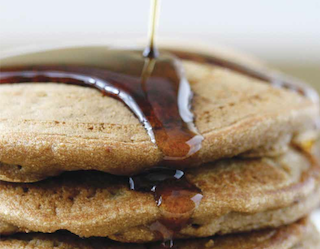
This is a recipe from the brand new Primal Blueprint Publishing book Primal Cravings: Your Favorite Foods Made Paleo . Order your copy today and claim a bunch of free gifts while the limited-time offer lasts. See all the details here.
Hazelnut, coffee, and maple together in a harmonious breakfast package. Take a traditional pancake, jack it up with some of this morning’s coffee, mix in some crushed hazelnuts, and top with a drizzle of maple syrup – and let’s not forget a few pats of butter too! It’s a high-octane way to start the morning, and a great Primal take on one of your old non-Primal favorites. Enjoy!
Servings: Makes about 10 pancakesa
Ingredients:
1⁄2 cup tapioca flour
1⁄2 cup coconut flour
1 teaspoon baking soda
1 teaspoon baking powder
1⁄4 cup hazelnuts, skinned and finely chopped
1⁄4 teaspoon coffee extract
1 cup brewed coffee, cooled 4 eggs
Butter for pan
Maple syrup (optional)
Instructions:
1. Whisk together the tapioca flour, coconut flour, baking soda, and baking powder in a bowl. Add the chopped hazelnuts and whisk to combine.
2. In a large bowl, whisk together coffee extract, coffee, and eggs.
3. Whisk the dry ingredients into the wet ingredients.
4. Melt a few tablespoons of butter over medium heat in a griddle pan or skillet. Working in batches, pour or ladle the pancake batter onto the griddle. Let the pancake cook about 2 other side for another 2 minutes or until browned.
5. Serve with maple syrup.
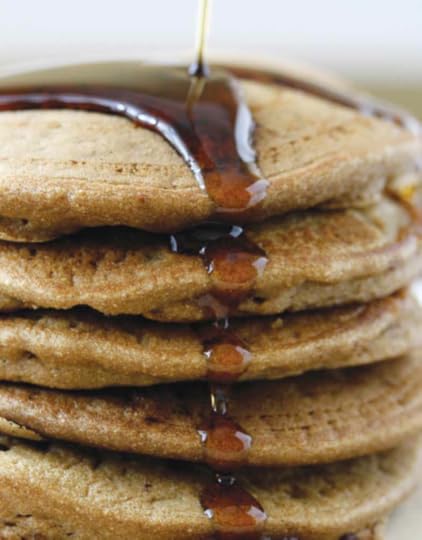
Grab a Copy of Primal Cravings: Your Favorite Foods Made Paleo and Claim Your FREE Gifts While the Limited-Time Offer Lasts!

May 10, 2013
Concrete Reasons to Continue on the Primal Path
It’s Friday, everyone! And that means another Primal Blueprint Real Life Story from a Mark’s Daily Apple reader. If you have your own success story and would like to share it with me and the Mark’s Daily Apple community please contact me here. I’ll continue to publish these each Friday as long as they keep coming in. Thank you for reading!
 Mark,
Mark,
I want to start by saying THANK YOU. Without you (and several thousand years of common sense), I was on the road to a significantly shorter and less fulfilling life.
My Primal success story was unintentional, but it couldn’t have come at a better time. My father was one to hop on random health crazes for a few weeks in order to lose weight, and the Primal Blueprint was his newest of many…or so I thought. I didn’t take it very seriously when he talked about it, but I figured I’d go on it with him for a week or so to try to keep him motivated.
This was me before that.
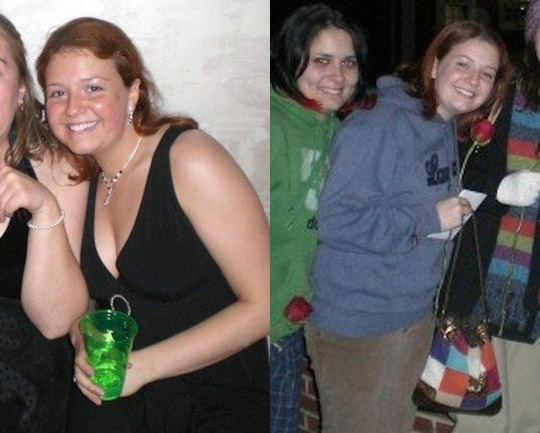
In August 2010, after just three days of completely Primal eating, a persistent and very frustrating rash that I’d been trying everything to get rid of for the last year disappeared. I didn’t immediately make the connection, but I loved the way that I felt while on the diet, so I kept going. Since I wasn’t totally serious about it, I still occasionally ate wheat products. Every time, without fail, the rash came back. Once the rash was officially diagnosed as a form of gluten intolerance, I had a very concrete reason to continue on the Primal path.
On top of the rash, I’d struggled with abnormally high blood pressure (typically around 150/110) since I was 18. It was almost overnight that I went from normal to hypertensive, and I had no family history and no debilitating habits like smoking that might have caused it. By the time that I started eating Primally, I had cut down my salt intake from ridiculous (adding salt to ramen ridiculous) to practically tasteless, and nothing changed. I was also on two different blood pressure medications that had done nothing, and I discontinued them around October of 2010. Eating Primally made a very tiny dent after a while, but I still didn’t see the results I was hoping for based on the success stories I’d been reading on Mark’s Daily Apple. I WAS losing weight, though, so I figured I just needed more time. I even started my own Primal recipe blog, Heather’s Primal Recipes.
Initially, I lost about 15 pounds (from 145 to 130). I couldn’t escape that plateau at 130, and I frequently got discouraged and spiraled into binge eating things that made me break out and feel awful. (Chinese takeout, anyone?) From August of 2010 to June of 2012, I went up and down on that roller coaster. Even on my best days, minimal exercise was a challenge. Thirty seconds of sprinting left me feeling winded and dizzy. To boot, my doctors (who were already angry at me for my newfound eating habits and lack of medication) didn’t want me to raise my heart rate too high, fearing heart attack.
In March of 2012, I finally listened to the one doctor who DIDN’T think my eating habits were unhealthful and got a renal duplex ultrasound. It turned out that I had a relatively unknown disease having NOTHING to do with eating habits called Fibromuscular Dysplasia, which causes arteries to grow like strings of beads instead of tubes. Unfortunately, because so little is known about it, it’s often confused with atherosclerosis (aka plaque). It was easy enough to point out that I had been following the SAD for several years WITH arterial stenosis before adopting this “artery clogging” diet, however. 
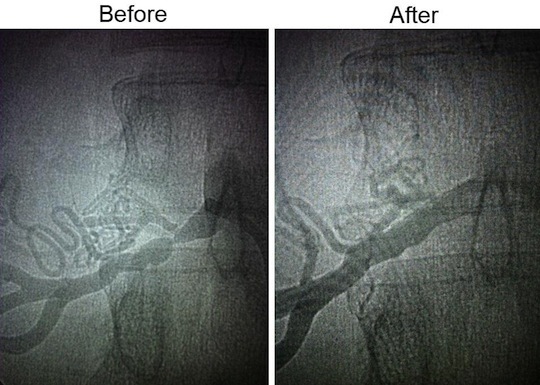
In June of 2012, I had balloon angioplasty to reopen my nearly closed renal artery. Within minutes of surgery completion, my blood pressure dropped to 117/67.
After about a week of bed rest and surgical recovery, I started to really pick up the Primal exercise plan, since I was now “allowed” to raise my heart rate. The weight couldn’t fall off fast enough. From June to September, I dropped from 130 to 118, (in total a size 10/12 to size 2/4) and I’m still going. I’ve never felt better.

Heather
Grab a Copy of Primal Cravings: Your Favorite Foods Made Paleo and Claim Your FREE Gifts While the Limited-Time Offer Lasts!

May 9, 2013
Why We Crave Comfort Foods
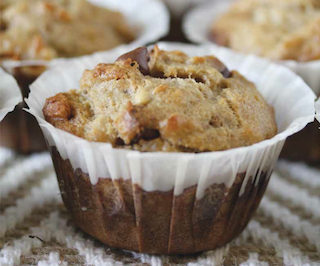
We all have them – ”comfort” foods that feel like more than just food. Far beyond the random edibles of our day, these are imbued with the likes of positive memories, celebratory identities, nurturing associations. They’re the feel-good recipes or psychological standbys that satiate us on a deeper level. Irrational as it might sound (but isn’t really), food is more than function. It’s more than taste or even nutrition (gasp!). Food, specifically our personal list of comforting favorites (resulting from cultural and emotional experience), has the power to shift our mood as well as our physiology.
When we go Primal, we end up rethinking our relationship with these old standbys. In some cases, we cherish the memory but let them go for the sake of health goals. We might experiment with adapting them, or we might simply reserve the right to enjoy them in their original forms on special occasions. However we re-envision our favorites post-Primal, I’d suggest we don’t need to throw out the concept of comfort food itself. Though the actual preferences are personal, the impact of comfort food as a whole is real – and measurable. Research has shown that eating – or even writing about – comfort food actually blunts negative emotions like loneliness. As with any phenomenon, the more we understand it, the better able we are to use it for good in our lives and health.
The Emotional Reasoning
For all of us, I think, food becomes imbricated with emotional associations, which evolve in layers of our upbringing, experience, and exposure. Were we given a particular food as a reward growing up? Were our favorites part of holidays or other celebrations? Maybe our mother made a certain food when we were feeling down. Perhaps our deepest, if not most numerous, associations come from childhood, but others come to us in salient points of adulthood. Think back to the last really good meal you had – the kind that leaves you calculating when you can go back for more. The best meals, of course, involve more than the food. It’s the company, the environs, the mood, the conversation, the occasion. The happier the event, the more convivial the atmosphere, the more intimate the friends or family, the richer the experience and more positive the memories.
The Physiological Reasoning
Fat and carbohydrates figure in prominently with the most cited comfort foods. Carbs can temporarily boost serotonin levels, which can leave us constantly running back for another neurochemical fix. Our favorite – fat – figures into the picture as well (although more favorably). Research shows, for example, that even when sensory experience is extracted, food (in this case, fat) soothes. When a group of study subjects viewed a sad movie or listened to sad music, subjects who received an injection of saturated fat were less affected emotionally (and showed less activity in brain regions associated with negative thoughts) than those who received saline shots.
The Social Reasoning
On the subject of loneliness… There’s something Primally human – and social – about the idea of comfort in food, in fact. For tens if not hundreds of thousands of millennia, we’ve bonded over food. Offering food as a gift or show of hospitality was critical to social bonding. It encouraged peace. It built alliances. In terms of our identification with common comfort foods, food psychology expert Brian Wansink and his team note (PDF) how social learning is critical “in teaching animals how to select food with needed nutrients and how to avoid ingesting toxins.” Comfort foods feel so universal because they are (within cultures anyway). We’re wired to eat what those around us show us is desirable because our evolutionary hardwiring tells us it must be safe and nutritious.
On an interesting gender note, Brian Wansink and team have also shown men and women gravitate toward different foods for comfort – men more toward meals and women toward snacks. Still, I know plenty of women who crave hearty, meaty foods and men who have a sweet tooth. For me, it’s an eclectic kind of smorgasbord – spaghetti sauce with sausage and a hint of clove, being one. I still make the recipe from time to time but substitute something Primal for the pasta (e.g. spaghetti squash or mushroom and peppers). It’s a family recipe of sorts, and I try to relish the memories as much as the food on the few occasions I dig out the recipe.
So, if we accept that the penchant for comfort food is innate, what do we do about the non-Primal nature of many old favorites? How do we allow for the “comfort” instinct in our Primal living – even harness it for a richer enjoyment of food and life?
Use the 80/20 Principle.
If you crave your non-Primal comfort foods seldom enough and can recover easily enough from them that they won’t derail your Primal plan, consider them fair game for the occasional 80/20 application.
Adapt the ones you can’t – or just don’t want – to live without.
Some of us, as much as we miss the original versions of our favorites just find they aren’t worth the side effects or backsliding. Take heart in the fact that it doesn’t have to be an all or nothing situation. Primal adaptations (I know a great book to help you out here.) are practical and totally legal options. In time, you’ll likely find that you enjoy the PB versions even more.
Experiment to find new favorites.
Consider the possibility that you haven’t yet found your favorite comfort food. Some of the foods I enjoy the most today are choices I never would’ve thought of years ago. You’re never done learning how to savor food (or life) in new ways.
Make new “comforting” memories.
When we accept that comfort food isn’t just about the food itself, we can recreate the other elements that feed into those soothing associations. Does a certain meal make us feel taken care of because we cherish the memory of a parent making it for us or perhaps with us? Do we associate a food with contentment or security because it was a grandparent’s recipe, and we relished those visits or holidays? We can obviously celebrate those memories for what they meant to us. In practical terms, however, we can also lay down new neural pathways for comfort and pleasure. All it takes is a little effort, a good recipe, and some repetition. Suddenly, you find yourself craving broiled shrimp on a bad day at the office.
Flesh out the experience.
The dining experience, that is. Beyond the food itself there’s what typically goes with it in the memories that play in our heads. We may not be able to transport our grandparents back to our kitchens, but we can enjoy a family photo night and a Primal adaptation of one of their recipes. We may not eat full blown desserts anymore, but we can keep people around the table laughing and talking after dinner with a good espresso or some dark chocolate. We might be surprised at how much of our enjoyment comes from the ambience, the company, the hospitality, the ritual of sharing a meal or just dining solo exactly the way we want.
Finally, the last point speaks to a greater lesson – that we need comfort in the first place. I, for one, see nothing wrong with healthy indulgence, but there’s more pleasure to be had in life than food. In this manically harried culture of ours, we’ve lost the art of self-care. I’m not talking about keeping your toe nails clipped or ironing your clothes. I mean things that go beyond basic hygiene and social norm.
Perform this radical exercise. Absolutely zero guilt, fear, or self-loathing allowed. Write a 100 things – yes, at least 100 – things that bring you comfort and pleasure. Yes, it’s a shocking, lotus-eating brand of exercise, but do it on good paper (or on the computer) because you’ll want to save it. Put it all on there – walking barefoot in warm sand to getting a scalp massage, alphabetizing your book collection to buying flowers, using power tools to relishing comfort foods. Now you have it – for when you need it or when you just feel like using it, which probably can’t be often enough.
Can you tell it’s almost Friday? Yes, now go cook yourselves something tantalizing, and relish it with all the voracity of a caveman/woman on a carcass.
Thanks for reading, everybody. Have a great end to the week.
Grab a Copy of Primal Cravings: Your Favorite Foods Made Paleo and Claim Your FREE Gifts While the Limited-Time Offer Lasts!

May 8, 2013
Introducing Primal Cravings!
 I am pleased to share Primal Cravings, the latest release from Primal Blueprint Publishing. This book will be available by direct order (with some cool additional free promo items, details below) for a limited time before it is released to the general public online and in bookstores. If you already have a collection of Primal/paleo cookbooks, let’s be clear that this volume distinguishes itself from the others in a few important ways. First and foremost is the emphasis on being able to enjoy your favorite foods, period. That’s right, it’s time to bring back some of your old favorites that were banished in the interest of going Primal! As you can see on the cover, this includes a big, fat, juicy burger with all the trimmings – even the bun! Oh, how about thin mint cookies, strawberry shortcake waffles, crispy chicken fingers, and the like? Get the picture? We’re talking delicious and highly creative meal and snack options that have been expertly modified by authors Brandon and Megan Keatley to be Primal-approved without sacrificing taste or texture.
I am pleased to share Primal Cravings, the latest release from Primal Blueprint Publishing. This book will be available by direct order (with some cool additional free promo items, details below) for a limited time before it is released to the general public online and in bookstores. If you already have a collection of Primal/paleo cookbooks, let’s be clear that this volume distinguishes itself from the others in a few important ways. First and foremost is the emphasis on being able to enjoy your favorite foods, period. That’s right, it’s time to bring back some of your old favorites that were banished in the interest of going Primal! As you can see on the cover, this includes a big, fat, juicy burger with all the trimmings – even the bun! Oh, how about thin mint cookies, strawberry shortcake waffles, crispy chicken fingers, and the like? Get the picture? We’re talking delicious and highly creative meal and snack options that have been expertly modified by authors Brandon and Megan Keatley to be Primal-approved without sacrificing taste or texture.
The 125 recipes in Primal Cravings are all are low-sugar, grain-free, gluten-free, and industrial oil-free. What’s more, unlike typical substitute recipes in many other paleo cookbooks, these new and original grain-free baking methods have almost exclusively eliminated the need for the typical expensive agents like almond flour and other nut flours and nut butters.
This multi-year project from the Keatleys is the product of intensive research, experimentation and perfecting recipes in their home kitchen. The Keatleys are certified CrossFit coaches in South Carolina and publishers of the popular Health-Bent.com website (check out their treasure trove of free recipes, workout tips, and motivational messages if you aren’t already familiar). In its essence, Primal Cravings sets out to provide the best of both worlds – delicious food to satiate our deep seated, visceral urges, made with ingredients that satisfy our ancient genetic needs for good health. Inside you’ll find assorted breakfasts, meat and main dishes, sides and salads, snacks, sweets and basics like bread, sauces, and dressings.
Primal Cravings is also a pleasant read. The recipes are presented in a simple, clear, easy-to-navigate format, with vibrant photos and detailed macronutrient analyses of each preparation. In addition to the recipes, bonus features include:
A simple and memorable overview of the tenets of a Primal/paleo diet
Primers on ingredients, tools, and stocking your kitchen
Menu suggestions for different occasions (quick, budget, feeding a crowd)
If you’ve been missing or looking for healthy, innovative ways to make breakfast egg dishes, waffles, pancakes, muffins, burgers, chili, pizza, chips, baked goods (cakes, pies, cookies, crackers, brownies) and frozen desserts; or global cuisine like gyros, spanakopita, moo shu, barbacoa, tacos, tikka masala and other favorites, Primal Cravings will open up a whole new world of pleasurable, Primal-approved possibilities.
Check out the following selection of photos for a taste of what the book has to offer (click “Play Again” if it has come to an end), and view an excerpt of the book at PrimalBlueprint.com.
Per Mark’s Daily Apple tradition, I’ve put together an exciting limited-time offer for this book release. It expires on Monday, Jun. 3, 11:59 pm PST.
BONUS PACKAGE #1:
Order 1 or more copies of Primal Cravings from PrimalBlueprint.com and get:
1. $5 Off the Cover Price - Knowing that upon mass release next month online retailers will aggressively discount off the cover price, I am doing the same here, lowering the $34.95 cover price to $29.95 only for the duration of this promotion.
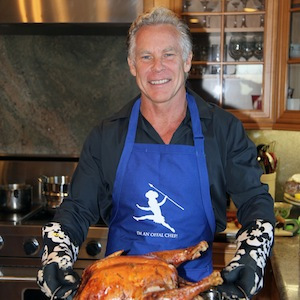
2. The Primal Blueprint “I’m an Offal Chef!” Apron ($20 value) – Keep tidy while you’re cooking your healthy Primal meals and look stylish doing it in this Primal Blueprint apron. The tagline “I’m An Offal Chef!” is a fun play on words that is sure to elicit some chuckles, and maybe even some questions about what it means to be Primal. I sure had fun with it last holiday season.
This apron has an adjustable neck strap to suit all shapes and sizes, and comes in a durable polycotton fabric that is built to last. With all the time you’ll be spending in the kitchen with this new book, I’m sure this bonus item will serve you well.
3. 30-Minute Podcast Interview with the Keatleys – In a 30-minute podcast with Primal Blueprint Publishing Managing Editor Brad Kearns, the Keatleys detail how their partnership took shape as they bonded – and argued – over food, and plunged enthusiastically into the Primal movement as cooking enthusiasts; some insights on fitness (and how healthy eating supports performance and recovery) from their experience as CrossFit coaches, and some freewheeling commentary about the book itself that will enhance your appreciation for who they are and the heart and soul effort that became Primal Cravings.
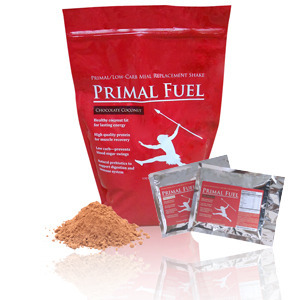
4. Single Serving of Primal Fuel – In the nearly three years that Primal Fuel has been available, thousands of people have tried it, and if the daily emails I receive from happy customers are any indication, nearly everyone absolutely loves it. Some prefer the delicious Vanilla Coconut Cream variety, others the decadent Chocolate Coconut. I’m more of a chocolate guy myself, so I have a Primal Fuel chocolate shake regularly for breakfast, when I’m on the road and to curb the odd sweet tooth I might get. I’m confident that once you taste Primal Fuel and take a look at the short list of healthy ingredients on the label (nutritious fats from coconut milk, the gold-standard version of whey protein, just enough sugar to be tasty and Primal at the same time, and prebiotics) that you’ll love it, and it will help you get and stay Primal. For those reasons, and because it’s a great way to satisfy Primal cravings I’ve included it in this bonus package. If you’ve been wondering about Primal Fuel, this is the perfect opportunity to see what it’s all about.
Click Here to Order Primal Cravings and Get Bonus Package #1 for FREE>>
BONUS PACKAGE #2:
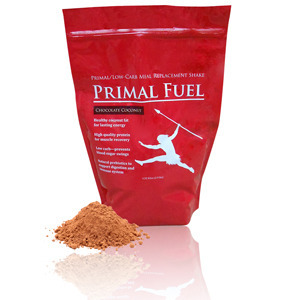
If you’d prefer to get a full 30-servings of Primal Fuel with your copy of Primal Cravings instead of just a sample of Primal Fuel, this bonus package for you.
Order the 30-serving supply of Primal Fuel on automatic delivery and get:
1. FREE copy of Primal Cravings
2. The Primal Blueprint “I’m an Offal Chef!” Apron ($20 value)
3. 30-Minute Podcast Interview with the Keatleys
4. Primal Fuel Blender Bottle ($8.95 value)
Click Here to Order Primal Fuel and Get Bonus Package #2 for FREE>>
Many thanks to everyone that purchases one or more copies of Primal Cravings over the next few weeks. The Keatleys, the entire Primal Blueprint team and I appreciate your support and hope that this new book will touch your lives just as Mark’s Daily Apple and previous Primal Blueprint books may have in the past. Grok on!
Fine Print:
Unlike previous retail channel promotions, this one is simple: You order the book directly from PrimalBlueprint.com and we send you all the free bonus items. No worries, no hassles!
This special bonus offer ends at 11:59 pm, Jun. 3, 2013 (PST).
Only orders placed on PrimalBlueprint.com will receive the bonuses.
Primal Cravings is not yet available on Amazon.com or at other retail locations.
Both domestic (U.S.) and international orders are eligible for the bonuses.
You will receive an email within an hour of placing your order that will provide you with instructions on how to access the podcast. This email is separate from your email receipt.
The podcast interview with the Keatleys can only be streamed online, and cannot be downloaded.
Access to the podcast interview expires 60 days after the end of this offer on Aug. 2, 2013.
The flavor of the free sample of Primal Fuel (Chocolate Coconut or Vanilla Coconut Creme) in Bonus Package #1 will be randomly distributed (i.e. the flavor you receive in your package will be a surprise!).
Bonus Package #2 only applies to orders placed for the 30-serving supply of Primal Fuel on automatic delivery. The 15-serving supply and non-automatic delivery orders of Primal Fuel are not eligible for this special offer.
Get Your Copy of Primal Cravings Today!

Mark Sisson's Blog
- Mark Sisson's profile
- 199 followers



